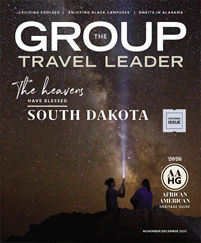Seeing destinations through the eyes of a local always provides a richer experience — but perhaps never more than when those locals are Indigenous.
Touring a place with the descendants of those who’ve inhabited lands for thousands of years provides a profound connection, revealing stories and traditions that are often overlooked. Indigenous guides offer insights into sustainable practices, ancient rituals, and the deep spiritual and cultural connections they hold with their homelands and their ancestors. In addition, Indigenous-owned and -operated tours empower communities, promoting respect and pride while providing valuable economic assistance and supporting the preservation of traditional folkways.
From the Great Plains to the Salish Sea of British Columbia, the lush rainforest of Hawaii and the majestic desert of New Mexico, here are five Indigenous tours that preserve heritage while helping your group foster a deeper understanding of the peoples who share our world.
Navajo Tours USA
New Mexico
Small groups will find the natural and spiritual wonders of northern New Mexico revealed when exploring the region with Navajo Tours USA. Kialo Winters of the Diné Nation (Navajo/Zia Pueblo) and Terri Winters (Navajo/White Mountain Apache) founded the operation 10 years ago, using their backgrounds in education to bring the history and mystery of their ancestral lands to life for visitors from around the world.
Hiking through the Bisti/De-Na-Zin Wilderness, your group may come across shark teeth and marine fossils projecting from the sandstone hoodoos, towering formations created as the land changed over millions of years.
“The composition, the strata of soil regarding geology and its history is all familiar,” said Kialo Winters. “What’s interesting is that the stories of our indigenous stories bridge that composition to our lore. A lot of our stories we see when we’re walking on the trails.
“The whole landscape just came alive, and that allowed us to put together a journey so our guests can understand the connections, and to give history to our lands. To say there is story there, these are very important areas for us to identify. And so what that does is sort of break down stereotypes of who and what Indigenous peoples are — to say that we are here, we do have a history. And these areas are very important to us.”
Imu Mea ‘Ai Food Tour
Hawaii
The furthest thing from a tacky tourist luau, Imu Mea ‘Ai Food Tour, a regenerative eco-tour, will give your group an authentic taste of Hawaiian culture, along with a traditional tasty feast. Preparing food (mea ‘ai) in an underground oven (imu) is an ancient practice at the heart of Hawaiian culinary culture. This food tour, which is available as a full-day or half-day experience, allows visitors to assist in the construction of the underground oven and the preparation of the locally sourced meal that is cooked within it, culminating in a joyful and delicious meal shared with members of the community.
Iopa Maunakea is the executive director for the nonprofit Men of PA’A, the social enterprise that operates the food tours.
“This is my family legacy, as far as perpetuating our Hawaiian culture, and living our family legacy of service to others,” said Maunakea. “We not only serving our initial local communities but now our visitor communities as well.”
Guests who participate in the full day tour gather materials and construct the oven that will roast a pig and an assortment of local vegetables. While the meal is cooking they participate in other activities — such as lei-making, hula or hikes — before enjoying the meal. For a half-day tour, visitors construct an imu and then enjoy a meal that was put in to roast in another oven earlier in the day.
“After the four-hour tour, people often go visit the volcano or go back to another activity,” said Maunakea. “On the longer one, they will stay with us all day. And the beautiful part about this whole thing is, imu is an ancient art — as ancient as hula, as ancient as the canoes. It’s a legacy practice. And that’s the beauty of it.”
Tatanka Rez Tours
South Dakota
People may not be immediately familiar with the Pine Ridge Indian Reservation, home to the Oglala Lakota Nation. Covering 2.1 million acres in the southwestern corner of South Dakota, it’s ranked as the poorest county in the United States. But many Americans will recognize the name Wounded Knee, the site of an 1890 massacre by federal troops that killed as many as 300 Lakota men, women and children, as well as a 1973 occupation that brought the indigenous rights movement to the forefront of the news.
Tianna Yellowhair was only 19 when she started Tatanka Rez Tours, the only Native-owned tour company in the state, 10 years ago. Each tour, from a few hours to a few days, is planned to accommodate the needs and interests of each individual group, be it a family of four or a fleet of motorcoaches.
“We want to bring [groups’] interests to the forefront while making sure they get an accurate account of history,” said Yellowhair. “We pick a meeting location, start with a little bit of Lakota language and an introduction of the area, and then from there, we will actually start our journey.”
Popular stops include the Historical Center at the Oglala Lakota College campus, where Tatanka Tours guide (and Tianna’s father) Guss is a faculty member; the Lakota Prairie Ranch, which serves a mean cheeseburger; and the Oglala Lakota Artspace.
“This is something that’s beyond an income now,” said Yellowhair. “It’s very much us being able to retell our stories, to break the stereotypes. We’re able to stand at the front to say, ‘this is how it was told, and this is how we are here on the reservation. This is our story, and this is what we’re sticking with.'”
Cherokee Nation Tours
Oklahoma
The largest Native American tribe in the United States, the Cherokee originally inhabited what’s now Alabama, Georgia, Tennessee and the Carolinas before being forced west along the Trail of Tears into the territory of Oklahoma. Now numbering almost half a million people, the Cherokee Nation is headquartered in the capital of Tahlequah, which was established in 1839.
Travel specialists at Visit Cherokee Nation will custom design a tour for every size and interest, but downtown Tahlequah is a must. The beautifully landscaped Cherokee Cultural Pathway is filled with Native art and links some of the capital’s most important sites, including the Cherokee National Historical Museum, the Cherokee National Supreme Court Museum and the Cherokee National Prison Museum.
Donna Tinnin is the senior manager of museums and events for Cherokee Nation Cultural Tourism and grew up in Tahlequah.
“When I was in junior high, my dad worked in our capitol building, which dates from 1869,” she said. “It’s now our National Historical Museum, but Dad prefers to remember it the way it was. It sits right in the middle of our beautiful historic downtown. Visitors will get a chronological view of who we are as a people — what we’ve been through, our resilience, and where we are today, still a thriving, sovereign society.”
Tinnin also recommends that groups plan to stop at the Cherokee Arts Center and its Spider Gallery, where one-of-a-kind pieces by local artists are available for purchase.
visitcherokeenation.com/group-tours
Homalco Culture and Wildlife Tours
British Columbia
Located between Campbell River and the mainland of British Columbia, the Discovery Islands are an archipelago set in a maze of intricate waterways. This is the home of the Homalco people, Homalco meaning “people of fast-running waters” in Ayajuthem, the traditional language of the northernmost Salish First Nations.
The Homalco First Nation (which has a population of about 500) owns and operates Homalco Culture and Wildlife Tours, which offers a variety of seasonal excursions throughout the area. Comfortable 12-person watercraft with heated cabins and onboard washrooms depart from the Campbell River terminal on Vancouver Island. The Deluxe Grizzly Bear and Culture Tour takes visitors on a journey through one of the best whale-watching spots in British Columbia to reach the village site of Aupe. This is one of the villages where the Homalco made their home before missionaries forcibly relocated them, separating families and forcing children into residential boarding schools. After a picnic lunch at beautiful Orford Bay, guides will lead your group on a hike in search of bears, eagles and other wildlife.
“As long as we’re sharing our stories on our terms, I think it’s a win-win for both us as Homalco people and for people who are very respectful and genuinely curious about learning,” said Chyanne Trenholm, the company’s general manager. “It provides us with a lot of different opportunities, socioeconomic opportunities and language and cultural revitalization. We’re still here, and this is what we’re doing today to reclaim ourselves, reclaim our future, reclaim our language and our lands. It’s just really positive for us.”









